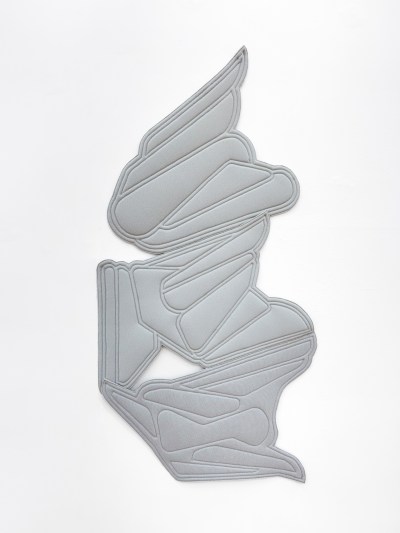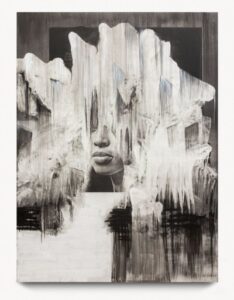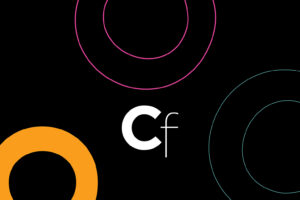Giulia Crețulescu Makes Synthetic Fabric Sexy

Fiber art is everywhere these days, in case you haven’t heard. And the trend tends toward work that is clearly labor-intensive and handmade, favoring folk traditions and natural fibers—which is hardly how any of us encounters fibers in the wild.
Giulia Crețulescu’s work stands apart for being made of material that’s more familiar: synthetic fabric. She sources it from a Ford automotive factory near her hometown—Craiova, Romania—repurposing the stuff of cheap seats. It’s rare to see such ubiquitous surfaces without a single stain. Even more impressively, Crețulescu manages to make the material somehow sexy.
This has a lot to do with all the straps that hang off her works, bondage-like. And the scale: her geometric shapes, mounted on walls, are roughly torso size. The straps include repurposed industrial seatbelts and other appendages that are intricately handmade. With Crețulescu’s craftsmanship, it’s tough to tell the difference between elements found and fabricated.
Crețulescu recently completed a PhD program in graphic arts in Bucharest. Her training is evident in the armor-like outlines she stitches as if in bas relief. She started sewing after growing frustrated with graphic design work that, done on a computer, “goes so fast.” Working with her hands, she found “a place to breathe.” Then, doubling down on resisting efficiency, she decided against making anything functional at all.
Before using Ford fabric, Crețulescu used pinstriped cotton, resulting in abstractions more like clothing that resemble armor-corset-suit conglomerates. They are decidedly androgynous and exquisitely tailored, made of material she bought as deadstock and will therefore never find again. That’s deliberate: Crețulescu bemoaned how clothes pile up in landfills, the synthetic fabrics resisting degradation. “I love fashion, but I cannot bring more clothes into the world,” she said when we spoke, shortly after she had returned to Romania following an impressive show at New York’s Fragment Gallery.

Giulia Crețulescu: Fuselage, ergonomics of temper, 2024.
Courtesy Fragment Gallery, New York
Growing up in an auto-industry town, Crețulescu became especially enamored of motorcycle gear. “It’s very graphic, and very close to the body,” she noted, describing padded jackets designed to protect the spinal cord. Such features began to stand out as she grappled with health concerns of her own, prompting her to think of motorcycle gear as contemporary armor. Soon she got into medieval armor too, fascinated by the way it can abstract anatomies into graphic geometries.
Crețulescu’s shapes evolve in drawings, then she makes patterns to scale. Though they are armor-inspired, the thought of executing jagged angles in metal struck her as unpleasant, sharp edges having as much potential to cause injury as to prevent it.
Her process shows that she thinks not only about the look but also the feel of her work. This gives her an advantage over those Minimalists who wanted to make art that viewers engage with their bodies as much as with their brains. Often, they did so in shapes and materials that were cold and uninviting, like metal squares. Crețulescu’s is definitively work that you feel in your bones.




